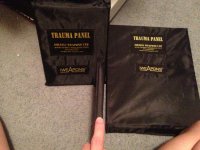Do you need trauma pads behind a hard armor plate thats a (stand alone) I seen testing on hard armor and sometimes there is dimples-force applied back to the wearer, but this is only on higher rounds such as 308 and 7.62x54R.
At 9:44 in this video there is a dimple on the other side. http://www.youtube.com/watch?v=tfVAnU8SabY
I guess that could really hurt the wearer.
Or would just a plain LVL IIA, II or IIA pad versus the trauma pad be better, as I under stand it trauma pads don't stop bullets, just catch blunt force, so soft armor be better?
At 9:44 in this video there is a dimple on the other side. http://www.youtube.com/watch?v=tfVAnU8SabY
I guess that could really hurt the wearer.
Or would just a plain LVL IIA, II or IIA pad versus the trauma pad be better, as I under stand it trauma pads don't stop bullets, just catch blunt force, so soft armor be better?

